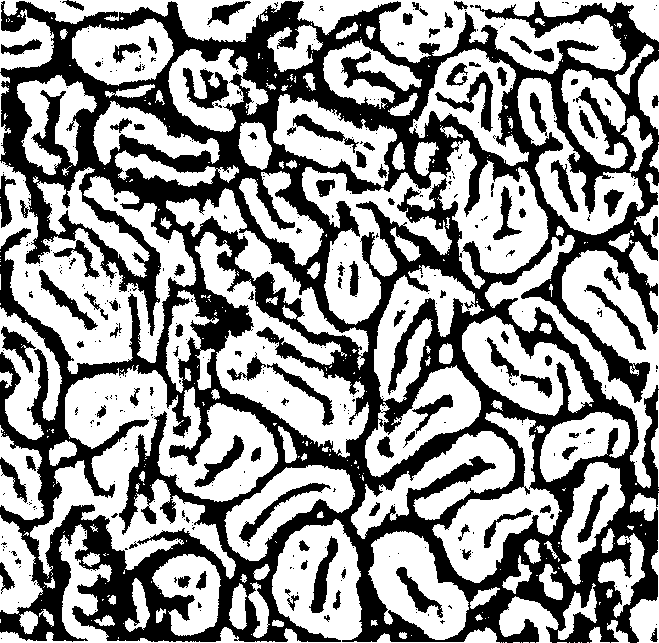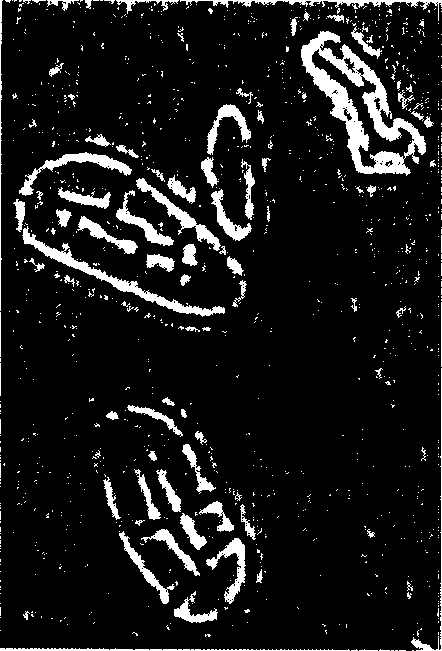Resin embedding fiber method for detecting fiber form
A technology of fiber shape and resin package, which is applied in the field of rapid embedding of textile fiber resin, can solve complex problems, achieve image quality improvement, fiber boundaries are clearly visible, and the embedding process is simple
- Summary
- Abstract
- Description
- Claims
- Application Information
AI Technical Summary
Problems solved by technology
Method used
Image
Examples
Embodiment 1~13
[0063] The fibers are:
[0064] Loose cotton fiber, ramie fiber, kapok fiber, ordinary viscose fiber, wool fiber, nylon trilobal fiber, polyester quatrefoil fiber, polyester trilobal fiber, polyester oval fiber, polyester polygonal fiber, polyester single hollow fiber, Acrylic straight fiber, acrylic blended fiber;
[0065] First, use an iron comb to comb each of the above-mentioned fibers neatly, and then tie the two ends of the fibers with yarn to ensure that the fibers are in a naturally stretched and straight state.
[0066] The above-mentioned fibers were respectively impregnated in the following embedding media:
[0067] Methyl methacrylate: butyl methacrylate: polymethyl methacrylate = 3: 2.6: 0.9, and in the bottle of BPO with 1% total monomer weight, vacuum the air bubbles in the fibers until no air bubbles appear until. Pour the embedding medium in the bottle into a polypropylene tube, seal both ends of the tube with stoppers, slightly tighten the yarns binding th...
Embodiment 14~16
[0072] Fibers used:
[0073] Loose cotton fiber, ramie fiber, acrylic fiber blended fiber, adopt the same detection method of embodiment 1.
[0074] First, use an iron comb to comb each of the above-mentioned fibers neatly, and then tie the two ends of the fibers with yarn to ensure that the fibers are in a naturally stretched and straight state.
[0075] The above-mentioned fibers were respectively impregnated in the following embedding media:
[0076] Styrene: polystyrene = 5 ~ 6: 1 = 5.5: 1, and in the bottle of BPO with 1% of the total weight of the monomer, vacuum the air bubbles in the fibers until no air bubbles appear. Pour the embedding medium in the bottle into a polypropylene tube, seal both ends of the tube with stoppers, slightly tighten the yarn that binds the ends of the fiber, keep the tube vertical, and place it at 100°C for about 2.5 hours of polymerization reaction. Prepare embeddings. For fiber cross-sectional images, see Figure 27 , 29 and 31.
Embodiment 17~19
[0078] The fiber that adopts: loose cotton fiber, ramie fiber, acrylic fiber blended fiber; Adopt the same detection method of embodiment 1.
[0079] First, use an iron comb to comb each of the above-mentioned fibers neatly, and then tie the two ends of the fibers with yarn to ensure that the fibers are in a naturally stretched and straight state.
[0080] The above-mentioned fibers were respectively impregnated in the following embedding media:
[0081] Vinyl acetate: polyvinyl acetate = 3: 1.8, and a bottle of BPO with 1% of the total weight of the monomers, vacuumed to remove air bubbles in the fibers until no air bubbles appeared. Pour the embedding medium in the bottle into a polypropylene tube. After the two ends of the tube are sealed with stoppers, slightly tighten the yarn that binds the ends of the fiber, and place it at a temperature of 83°C for about 1.5 hours of polymerization reaction, and then raise the temperature to Polymerize at 120°C for 1.5h to prepare the...
PUM
| Property | Measurement | Unit |
|---|---|---|
| thickness | aaaaa | aaaaa |
| thickness | aaaaa | aaaaa |
Abstract
Description
Claims
Application Information
 Login to View More
Login to View More - R&D
- Intellectual Property
- Life Sciences
- Materials
- Tech Scout
- Unparalleled Data Quality
- Higher Quality Content
- 60% Fewer Hallucinations
Browse by: Latest US Patents, China's latest patents, Technical Efficacy Thesaurus, Application Domain, Technology Topic, Popular Technical Reports.
© 2025 PatSnap. All rights reserved.Legal|Privacy policy|Modern Slavery Act Transparency Statement|Sitemap|About US| Contact US: help@patsnap.com



